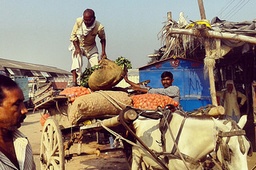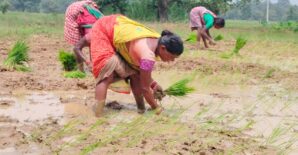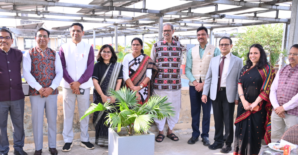
Farmer offloading the produce at wholesale market in Lucknow.
Source:(flickr) Pallavi Rajkhowa/IFPRI
Strengthening rural-urban linkages is key to help achieve SDG-2 in India
The world is rapidly urbanising. Currently, more than half of the world’s population lives in urban areas, and by 2050, as much as 66% is projected to be urban, with much of this rise taking place in developing countries. India is no exception: 33% of the population is urban and will rise to 50% by 2050.
What does this mean for the world and India’s food security, nutrition and ability to meet the Sustainable Development Goals (SDGs)?
The International Food Policy Research Institute’s 2017 Global Food Policy Report highlights how rapid urbanisation brings unique challenges to rural and urban areas, and strong linkages between these sectors can help achieve SDG-2 (end hunger, achieve food security and improved nutrition, and promote sustainable agriculture).
Urbanisation comes with challenges to agriculture and nutrition. Higher urban incomes are associated with a dietary transition to more animal-sourced food, fats and oil, refined grains, and fruits and vegetables, which requires more intensive use of natural resources. Urban lifestyles tend to increase consumption of processed foods and the urban poor are often limited to cheap unhealthy foods. At the same time, as urban population grows, hunger and under-nutrition will also increase in urban areas. In addition to access to healthy and nutritious foods, access to clean water, toilets and sanitation will also be challenges to hunger and malnutrition.
Yet rapid urbanisation brings opportunities, as the rise in urban food demand from rapid urbanisation for increased and diversified food production in rural areas can contribute to improved farmers’ livelihoods. To take advantage of these opportunities, strong rural-urban linkages are needed.
Rural-urban linkages are the physical, economic, social and political connections that link remote areas to large cities through smaller towns and cities in between. Where links are strong, rural farmers can sell larger shares of produce in urban markets, labourers can migrate or commute to nearby towns for seasonal work.
In 2016, the government set a goal to double farmers’ income by 2022 and create a budget that supports the agriculture sector. It is also increasing investment in infrastructure, irrigation, education and training, and healthcare. The National Food Security Act, Mid Day Meal Scheme and Anganwadi Centres contribute to tackling food and nutrition insecurity. Nevertheless, a comprehensive policy to improve agricultural productivity, strengthen value chains, promote diversification and agro-processing, and reduce food loss and waste is necessary to accelerate agricultural growth. Moreover, such a policy is needed to increase farm incomes and spur employment in rural areas, while improving the availability of diverse, healthy, nutritive and safe foods in urban areas. In this regard, policy coordination across rural, peri-urban and urban areas will be critical.
To strengthen value chains of agricultural commodities and improve market efficiency, a provision has been made to develop e-NAM. However, to establish efficient and inclusive rural-urban value chains, institutional arrangements that support the participation of marginal and small farmers who often have little marketable surplus are further needed.
Production in urban and peri-urban areas is shifting towards resource-intensive foods such as vegetables, dairy, meat and poultry to meet the rapidly growing demands. To veer production to rural areas—thereby reducing pressure on increasingly scarce urban and peri-urban lands—rural agri-infrastructure such as cold chains, cold storage and processing facilities is necessary. Leveraging towns and intermediate cities to facilitate economic and social connections between rural and urban areas, and improving rural infrastructure is crucial.
Concerns for food safety and critical civil amenities in the context of rapid urbanisation cannot be overlooked. As food and agricultural markets develop, quality and food safety standards will become increasingly important. Rapid urbanisation without safe drinking water, drainage, housing and hygiene facilities needs to be addressed, especially considering India’s slow decline in under-nutrition.
To end hunger and malnutrition in India and beyond, we must find solutions that consider the historic, ongoing trends of rapid urbanisation. Doing so is key in India, where despite progress 15% are hungry and 39% children are stunted. Improving links between rural and urban areas is a critical start.
Shenggen Fan is Director General and P K Joshi is Director South Asia, IFPRI.
This piece was originally published in The Financial Express.



